Scanreco D3DRCDRBM DRC-DR D3, DRC-BM D3 User Manual 21126744 enGB 151014 indd
Scanreco AB DRC-DR D3, DRC-BM D3 21126744 enGB 151014 indd
Scanreco >
User Manual

Operating/assembly instructions
DRC-DR D3 and DRC-BM D3 radio receivers
151014 enGB 211 267 44 719 IS 975
2
211 267 44.indd/151014 © Terex MHPS GmbH
Further documents:
DRC-10 D3 operating/assembly instructions 211 266 44 719 IS 975
DRC-J D3 operating/assembly instructions 211 271 44 719 IS 975
Manufacturer’s address:
Original operating/assembly instructions
Terex MHPS GmbH
Forststrasse 16
40597 Düsseldorf, Germany
www.demagcranes.com
mhps-info@terex.com
211 267 44.indd/151014 © Terex MHPS GmbH
3
Contents
1
General
4
1.1
Information on the DRC-DR radio receiver
4
1.2
General information
4
1.3
Information on the operating/assembly instructions
4
1.4
Symbols/signal words
5
1.5
Liability and warranty
6
1.6
Copyright
6
1.7
Spare parts
6
1.8
Definitions
7
1.9
After-sales service
8
1.10
Disposal of machine parts
8
2
Safety
9
2.1
General
9
2.2
Intended use
9
2.3
Responsibility of the owner
10
2.4
Operating personnel requirements
11
2.5
Personal protection equipment
11
2.6
Regular inspections
11
2.7
Safety instructions for installation and disassembly
11
2.8
Safety instructions when first putting the unit into service after completing
installation
12
3
General description
13
3.1
Transmitter/receiver interface
13
3.2
Transmission method
13
4
Technical data
14
5
Putting the DRC-DR radio receiver into operation for the first time
15
5.1
Safety instructions
15
5.2
Installing the radio receiver card
16
5.3
Function following installation
18
5.4
Putting the receiver into operation for the first time
18
6
Using DRC radio controls
19
6.1
DRC-DR receiver operating functions in connection with a transmitter
19
6.1.1
F1 function key
19
6.1.2
F2 function key
19
6.1.3
F1/F2 function keys – additional functions
19
6.1.4
Horn key, 1st stage
19
6.1.5
Horn key, 2nd stage
19
7
International postal approval
20
P
FCC and Industry Canada Information
22
4
211 267 44.indd/151014 © Terex MHPS GmbH
1 General
You have purchased a Demag product.
If special designs or additional options are ordered or the latest technical
modifications are incorporated, the actual scope of supply may differ from the data
and information as well as from the illustrations described here. If you have any
questions, please contact the manufacturer.
DRC-DR radio receivers may only be operated by personnel who are fully familiar
with the operating/assembly instructions.
DRC D3 (3rd generation) transmitters and receivers are successors to the D2
generation of DRC units.
D3 units are to replace D2 generation radio systems wherever D3 units are
allowed to be operated without the need for any registration or fees. In this context,
see section 7 „International postal approval“.
DRC D3 generation units are not technically compatible with units from the
previous DRC D2 generation. This means that D3 generation transmitters and
receivers cannot be combined with D2 units.
These operating/assembly instructions are designed to provide the owner with
appropriate instructions for safe and correct operation and for maintenance. These
operating/assembly instructions are an integral part of the DRC-DR radio receiver.
Every individual given the task of transporting, installing, commissioning,
operating, maintaining and repairing DRC-DR radio receivers and their additional
equipment must have read and understood the items listed in the following:
• the operating/assembly instructions
• the safety regulations
• the safety instructions in the individual chapters and sections.
The operating/assembly instructions must be available to operating personnel at
all times in order to prevent operating errors and to ensure smooth and trouble-free
operation of our products. They must be kept available in the immediate vicinity at
all times.
1.1 Information on the
DRC-DR radio receiver
1.2 General information
1.3 Information on the
operating/assembly
instructions
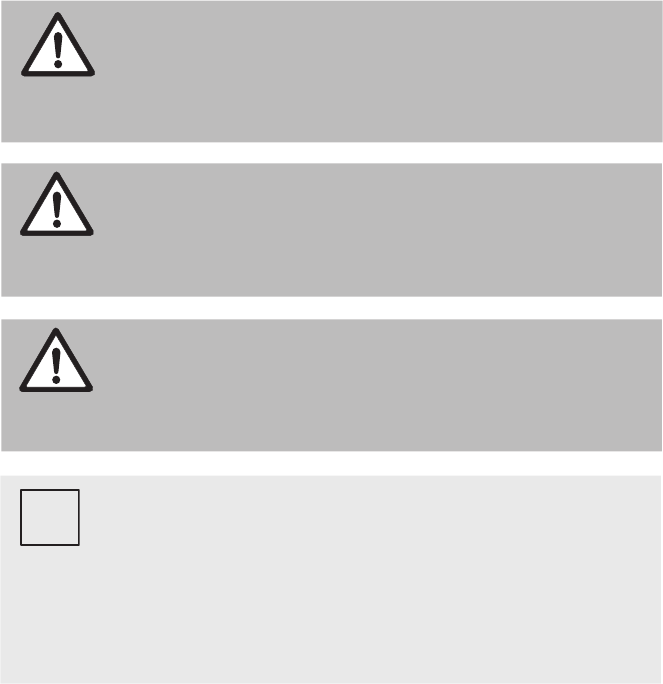
5
211 267 44.indd/151014 © Terex MHPS GmbH
1.4 Symbols/signal words
NOTE
Operating hazard for the DRC-DR radio receiver
• This symbol indicates information on the appropriate use of DRC-DR re-
ceivers.
• Failure to follow these instructions may result in malfunctions, damage or
pollution of the environment.
DANGER.
This symbol indicates an immediate hazard which can result in serious injury
or death.
WARNING.
This symbol indicates a possibly hazardous situation which might result in seri-
ous injury or death.
CAUTION.
This symbol indicates a possibly hazardous situation which might result in
medium to light injury.
i
Important safety information and instructions are marked by corresponding sym-
bols and signal words in these operating/assembly instructions.
Safety instructions and information must be followed. Follow these instructions
with care to avoid any accidents, injuries or damage.
Any locally applicable accident prevention regulations and general safety regula-
tions must also be followed.
The following symbols and instructions warn against possible injuries or damage
and are intended to assist you in your work.

6
211 267 44.indd/151014 © Terex MHPS GmbH
Wearing parts are not subject to liability for defects.
We reserve the right to incorporate technical modifications within the scope of
improving the operating characteristics and further development of the DRC-DR
radio receiver.
These operating/assembly instructions must be treated confidentially. They
are only intended to be used by people who work with or on the DRC-DR radio
receiver.
Any and all content, texts, drawings, images and any other information are
protected within the sense of copyright law and are subject to further industrial
rights. Any misuse is an offence.
No part of this documentation, in whole or in part, may be reproduced, distributed,
shown in public or used in any other way without specific prior consent. Infringe-
ments are an offence resulting in obligatory compensatory damages. Further rights
reserved.
All industrial rights reserved.
Only genuine Terex MH spare parts may be used.
The use of unauthorised spare parts renders null and void any claims for warranty,
service, damages or liability against the manufacturer or his appointed personnel,
dealers and representatives.
1.5 Liability and warranty All information included in these operating/assembly instructions has been
compiled on the basis of the relevant regulations, state-of-the-art engineering
principles and our many years of experience.
NOTE
These operating/assembly instructions must be read carefully before starting
any work on and with the DRC-DR receiver, especially before the unit is put
into operation for the first time. The manufacturer assumes no liability for any
damage which results from the following:
• Non-compliance with the operating/assembly instructions
• Inappropriate use of the DRC-DR radio receiver
• Operation by insufficiently trained personnel
• Unauthorised conversions
• Any technical modifications
i
1.6 Copyright
1.7 Spare parts
CAUTION.
Defective spare parts
Incorrect or defective spare parts may cause damage, malfunctions or
complete failure of DRC DR receivers.
Only use genuine spare parts or parts approved by Terex MH.
For safety-relevant wear parts, genuine Demag spare parts must always be
used.
Safety-relevant wear parts are, for example, brake linings, ropes, etc.
7
211 267 44.indd/151014 © Terex MHPS GmbH
1.8 Definitions Owner
Owners (employer, company) are defined as persons who own a radio control sys-
tem and who use it as intended or allow it to be operated by suitable and instructed
persons.
Operating personnel/operator
Operating personnel are defined as persons entrusted by the owner of a radio
control system with operation of the radio control system.
Specialist personnel
Specialist personnel are defined as persons assigned by the owner of the
radio control system to carry out special tasks such as installation, setting-up,
maintenance and fault elimination.
Qualified electrician
Qualified electricians are defined as persons who, owing to their technical train-
ing, knowledge and experience of electric equipment as well as knowledge of the
relevant standards, codes of practice and regulations, are able to assess the tasks
given to them and to identify and eliminate potential hazards.
Trained person
Trained persons are defined as persons who have been instructed and trained for
the tasks assigned to them and on the possible hazards resulting from incorrect
handling and who have been informed about the required protective devices,
protective measures, relevant regulations, codes of practice, accident prevention
regulations and operating conditions and who have proven their qualifications.
Experienced technician
Experienced technicians are defined as persons, who, owing to their technical
training and experience, have sufficient knowledge of radio control systems
and are familiar with the relevant national industrial safety regulations, codes
of practice, accident prevention regulations, directives and generally accepted
engineering standards enabling them to judge the safe operating condition of radio
control systems.
Assigned expert engineer (where the rules and regulations of the German
Social Accident Insurance (DGUV) apply in the Federal Republic of Germany,
for determining the S.W.P.)
An assigned expert engineer is defined as an experienced technician specifically
assigned by the manufacturer to determine the remaining duration of service
(service life) of rope hoists (S.W.P. = safe working period) and to carry out a
general overhaul of rope hoists.
Authorised expert engineer (where the rules and regulations of the German
Social Accident Insurance (DGUV) apply in the Federal Republic of Germany)
In addition to the expert engineers of the Technical Supervisory and Inspection
Board, an authorized expert engineer for the inspection of radio control systems
is defined as an expert engineer authorized by the Industrial Employers’ Mutual
Insurance Association.
Radio control system
Radio control systems are systems used for wirelessly controlling the lifting, lower-
ing and travel motions of loads on cranes, crabs, machinery and installations.

8
211 267 44.indd/151014 © Terex MHPS GmbH
1.9 After-sales service Our after-sales service will provide you with all technical information on Terex MH
products and their systematic application.
Should you have any questions regarding our products, please refer to one of our
after-sales service centres, the relevant representative or the head office in Wetter.
Please quote the serial or order no. in any correspondence or for spare part or-
ders.
Specifying this data ensures that you receive the correct information or the re-
quired spare parts.
Manufacturer’s address:
Terex MHPS GmbH
Forststrasse 16
40597 Düsseldorf, Germany
www.demagcranes.com
mhps-info@terex.com
Addresses and contacts
The current addresses of the sales offices in Germany and the subsidiaries and
agencies worldwide can be found on the Terex MHPS GmbH homepage at
www.demagcranes.com/Contact
Unless a return or disposal agreement has been concluded, recycle separated
components after proper removal:
• Scrap any remaining metallic material
• Dispose of plastic elements for recycling
• Separate and dispose of any other components by material type
NOTE
Electric scrap, electronic components, lubricants and other auxiliary materials
are subject to special disposal regulations and may only be disposed of by
certified companies.
i
National disposal regulations must be considered regarding environmentally
friendly disposal of the electric components and machine parts. Further information
can be obtained from corresponding local authorities.
1.10 Disposal of machine
parts
9
211 267 44.indd/151014 © Terex MHPS GmbH
The Safety chapter provides an overview of all important safety aspects for op-
timum protection of personnel as well as safe and trouble-free operation of the
DRC-DR radio receiver.
At the time of its development and manufacture, the DRC-DR radio receiver was
built according to generally accepted engineering standards and is considered to
be safe to operate. The DRC-DR radio receiver may still be a cause of danger if it
is not used correctly or as intended by suitably trained personnel.
Knowledge of the contents of the operating/assembly instructions is one of
the requirements necessary to protect personnel from hazards and to avoid
malfunctions and, therefore, to operate the DRC-DR radio receiver safely and
reliably.
Any conversions, modifications or additions to the DRC-DR radio receiver are
prohibited unless approved in writing by Terex MH.
The DRC-DR radio receiver is intended to be used as a receiver unit for DRC-10
and DRC-J radio transmitters. The scope of functions is exclusively designed for
wireless remote control of crane installations with Demag DR rope hoists.
For these applications, therefore, cable-connected control equipment (control
pendants) can be dispensed with. The operator can position himself as required.
He can freely move loads from a safe distance in line with local conditions.
DRC transmitters and receivers meet the requirements of the standards and
regulations listed in the EC conformity declaration. The specified EC conformity
declaration is an integral part of the relevant operating/assembly instructions.
DRC transmitters and receivers do not require any registration or operating fees,
see section 7 “International postal approval”. The benefits that this provides for the
user are also utilised by some other manufacturers of devices for communications
and telemetry applications. The consequence of this is that the relevant approved
frequency ranges may be used by many transmitters at the same time, depending
on the time and location.
The transmission method used by Terex MH is designed for the most robust and
interference-resistant radio transmission between the transmitters and receivers of
the DRC range.
Frequencies in the so-called 2,4 Ghz ISM band are used for transmission of radio
signals between transmitters and receivers.
Despite all of the technical precautions taken by Terex MH, it cannot be entirely
excluded that the transmission characteristics of other radio systems are impaired,
in particular devices supplied by other manufacturers that use the same frequency
range, or that the transmission characteristics of the system supplied by Terex MH
are negatively affected.
In such cases, interference or radio connection interruptions may occur, which
disrupt the communication and function of a system supplied by Terex MH or other
manufacturers. Such impairment or interference does not constitute a defect on
the part of DRC transmitters/receivers.
Terex MH accepts no liability for wilful or grossly negligent behaviour. The number
of transmitters that operate without any interference in a given area depends
on the relevant radio solution design of all systems and the selectivity of each
individual system.
If this limit is exceeded continuously or for certain periods, additional technical
measures may be necessary in order to ensure simultaneous and interference-
free operation of the radio systems. Whether and to which extent such measures
are required can only be determined by means of suitable measurements on site
or when the system is put into operation. Terex MH is not responsible for such
additional technical measures.
DRC D3 transmitters and receivers can be used for multiple transmitter operation
as well as multiple receiver operation. Refer to the corresponding operating/
assembly instructions for details.
2 Safety
2.1 General
2.2 Intended use
10
211 267 44.indd/151014 © Terex MHPS GmbH
DRC radio control systems may only be operated when in perfect working order by
trained personnel in accordance with the relevant safety and accident prevention
regulations. This also includes compliance with the operating and maintenance
conditions specified in the operating/assembly instructions.
National occupational safety and health regulations must be observed and
followed.
For intended use, the information in the operating/assembly instructions for the
radio transmitter used (DRC-10/DRC-J) and the machine/crane installation to be
controlled must be complied with in addition to the information contained in these
operating/assembly instructions (see accompanying documents, page 2).
Serious personal injury or damage to property may occur in the event of:
• unauthorised removal of covers,
• inappropriate use of the product/system,
• incorrect operation,
• insufficient maintenance,
• working on live parts.
Information on safety at work refers to the regulations of the European Union that
apply when the DRC-DR radio receiver is manufactured. The owner is obliged to
ensure that the specified industrial safety measures comply with the latest rules
and regulations and to observe new regulations during the entire service life of the
DRC-DR radio receiver. Local industrial safety legislation and regional regulations
and codes of practice applicable at the site of operation of the DRC-DR radio
receiver must be observed outside the European Union.
General safety, accident prevention and environmental protection regulations that
apply where the DRC-DR radio receiver is in operation must be observed and
complied with in addition to the safety instructions contained in these operating/
assembly instructions.
The owner and any personnel authorised by him are responsible for correct
operation of the DRC-DR radio receiver and for clearly defining responsibilities for
installation, operation, maintenance and cleaning.
The operating/assembly instructions must be followed in full and without any
limitations.
The operating/assembly instructions must, if required, be supplemented by the
owner with instructions relating to organisation of work, working procedures,
authorised personnel, supervising and reporting obligations, etc.
Furthermore, the owner must ensure that
• any further working and safety instructions resulting from the risk assessment of
the DRC-DR radio receiver workplaces are specified in operating procedures.
• the operating/assembly instructions are always kept available in the immediate
vicinity of the DRC-DR radio receiver for installation, operating, maintenance
and cleaning personnel.
• personnel are trained in accordance with the work to be performed.
• the DRC-DR radio receiver is only operated when in safe and proper working
order.
• the safety devices are always kept freely accessible and are checked regularly.
• the national regulations for use of the DRC-DR radio receiver are observed.
The owner is urged to develop procedures and guidelines for any malfunctions, to
instruct users and to affix these instructions at a suitable place where they can be
easily seen.
2.3 Responsibility of the
owner
11
211 267 44.indd/151014 © Terex MHPS GmbH
Only authorised and trained personnel may work on the DRC-DR radio receiver.
Personnel must have received instruction on the DRC-DR radio receiver functions
and any hazards that may occur.
Every individual given the task of working on or with the DRC-DR radio receiver
must have read and understood the operating/assembly instructions before any
work starts.
Persons under the influence of drugs, alcohol or medicines which affect their
reactions must not work on or with the DRC-DR radio receiver.
Age and job-specific regulations relevant at the place where the DRC-DR radio
receiver is operated must be observed for the selection of any personnel.
Personnel are obliged to report to the owner without delay any changes to the
DRC-DR radio receiver that impair safety.
For maintenance work on the DRC-DR radio receiver, the owner may only employ
persons (specialist personnel)
• who are at least 18 years of age,
• who are mentally and physically suitable,
• who have been instructed in maintenance of the DRC-DR radio receiver and
who have proven their qualification to the owner in this respect.
When work is carried out on or with the DRC-DR radio receiver, the following must
always be worn:
• Protective clothing, closely fitting working clothes (low tear strength, no loose
sleeves, no rings or any other jewellery, etc.).
• Safety shoes to protect against falling parts and against slipping.
• Safety helmet to be worn by everybody in the danger zone.
The owner of the DRC-DR radio receiver may be obliged to carry out regular
inspections by national industrial safety legislation and regional regulations. This
is regulated by the rules and regulations of the German Social Accident Insurance
(DGUV) in the Federal Republic of Germany, for example. These specify that
• the DRC-DR radio receiver must be inspected before it is put into operation,
• the DRC-DR radio receiver must be inspected regularly.
The owner is obliged to ensure that the DRC-DR radio receiver complies with the
latest rules and regulations and to observe new regulations at all times.
If no comparable inspection regulations or requirements apply at the place where
the DRC-DR radio receiver is operated, we recommend compliance with the
above-mentioned regulations.
• Installation and disassembly work may only be performed by experienced
technicians.
• Installation and disassembly work must be co-ordinated by the person carrying
out the work and the owner within the scope of their responsibility.
• The working and danger zone must be made safe.
• The installation must be isolated in accordance with the relevant electric regula-
tions.
• Customer-specific regulations must be observed.
• Only appropriate, tested and calibrated tools may be used.
• If equipment is disassembled, any waste material must be disposed of by the
owner in an environmentally compatible way in compliance with relevant regula-
tions.
2.4 Operating personnel
requirements
2.5 Personal protection
equipment
2.6 Regular inspections
2.7 Safety instructions
for installation and
disassembly
12
211 267 44.indd/151014 © Terex MHPS GmbH
• The working and danger zone must be made safe.
• First check that the voltage and frequency specified on the type plate match the
control voltage of the installation/machine.
• The commands for controlling the motion drives are disabled in the DRC-DR
radio receiver until a transmitter has been clearly assigned and specified by
means of the relevant initialisation dialogues and the crane ID. See transmitter
operating/assembly instructions (DRC-10 or DRC-J).
• In the course of putting the equipment into service, it may be necessary to
render safety devices or features inoperative while adjustment work or function
checks are carried out.
• Work may need to be carried out in the danger zone when the product is put
into service. Therefore, it must be ensured that only appropriately trained
personnel are employed for this work.
2.8 Safety instructions
when first putting the
unit into service after
completing installation
13
211 267 44.indd/151014 © Terex MHPS GmbH
3 General description
3.1 Transmitter/receiver
interface
Demag DRC radio control systems are designed for wireless control of hoist units
and cranes. They are the man/machine interface for manually controlled crane
installations. The relevant EU directives and standards are complied with for this
application.
A DRC D3 radio control system consists of one or more transmitters as well as at
least one or, if required, more receivers.
These operating/assembly instructions refer to DRC DR D3 receivers in
combination with their matching DRC-10 D3 or DRC-J D3 transmitters.
The DRC-DR radio receiver is a PCB that is designed to be installed in the electric
equipment cover of a DR hoist unit. The interface of this receiver component to
the crane control system is the Can bus with the CANopen safety protocol and
the power supply via the DR electric equipment. The DRC-DR radio receiver is
exclusively suitable for operation with a DR hoist unit with processor control.
Demag DRC-DR radio receivers are equipped for bi-directional radio transmission
and transmit information to DRC-10 hand-held transmitters or DRC-J joystick
controls. This increases the safety and reliability of the radio system. Status
information for the crane control system and the receiver is shown on the display
of the DRC-10 or DRC-J transmitter.
Frequencies in the so-called 2,4 Ghz ISM band are used for transmission of radio
signals between transmitters and receivers.
The new proprietary radio transmission method used for DRC D3 meets the most
demanding requirements in terms of transmitter density and co-existence with
other equipment that operates in the 2,4 GHz ISM band. The radio transmission
method combines various transmission mechanisms: A frequency-hopping system
ensures that radio transmission is robust and highly resistant to interference – an
adaptive behaviour (Listen Before Talk) combined with this enables interference
with neighbouring radio applications to be effectively eliminated.
3.2 Transmission method
14
211 267 44.indd/151014 © Terex MHPS GmbH
CAN bus output
LED indicators for radio connection (yellow LED)
Line voltage (green LED)
Internal error (red LED)
Enclosure IP 55 integrated in rope hoist controls
Temperature range - 20° to + 70° C
Weight of radio receiver 94 g
Supply voltage +5 V DC (from the rope hoist controls)
Typical range approx. 100 m
Frequency range 2,4 GHz ISM band, 2405 - 2480 MHz
4 Technical data
DRC-DR radio receiver PCB
Radio transmission
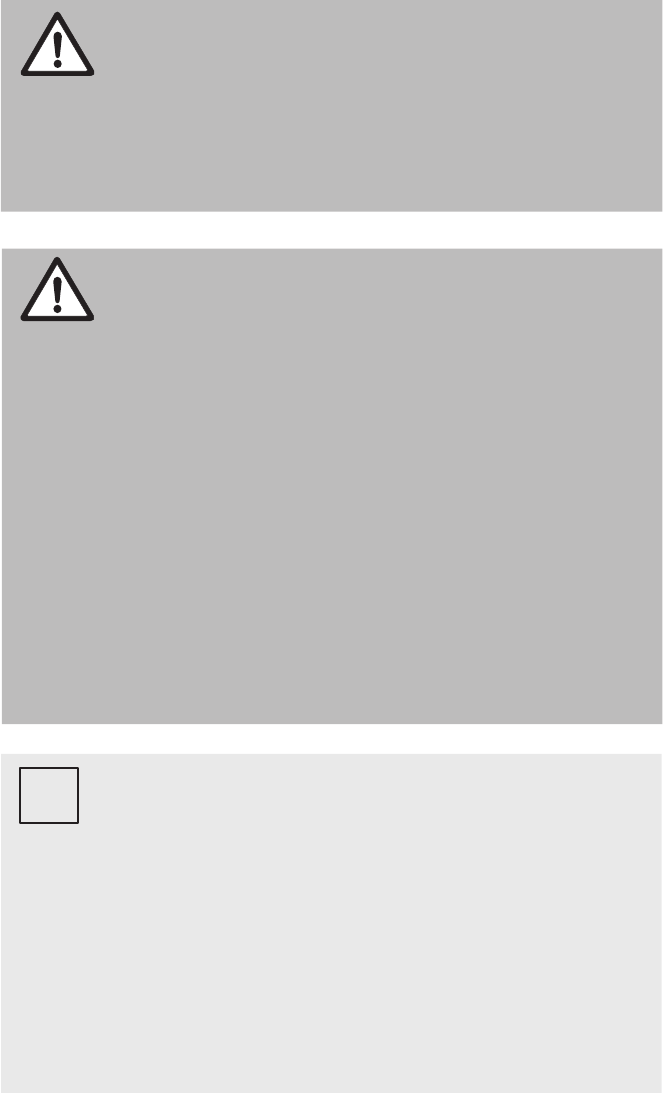
15
211 267 44.indd/151014 © Terex MHPS GmbH
5 Putting the DRC-DR radio receiver into
operation for the first time
WARNING.
Risk of injury if incorrectly assembled
Incorrect installation may result in severe injury and/or damage to prop-
erty.
Therefore, this work may only be carried out by authorised, instructed person-
nel who are familiar with the principle of operation of the DRC-DR radio re-
ceiver in compliance with all safety regulations:
– Ensure sufficient working clearance before starting assembly work.
– Secure and fence off the working and danger zone.
– Wear protective clothing.
– Be careful when working on open components that have sharp edges. Risk
of injury.
– Keep the working area clean and tidy. Store any machine parts or fittings
and tools that are not needed in such a way that there is no risk of them
falling.
– Fit components correctly and as intended. Comply with specified bolt tight-
ening torques. Incorrectly fitted components may fall and cause severe
injuries.
DANGER.
Electric current.
Electric energy may cause very severe injuries.
Work on the electric equipment may only be carried out by specialists or by
trained personnel.
Before starting work, switch off the electric power supply and secure it
against switching on again.
5.1 Safety instructions
NOTE
These operating/assembly instructions must be read carefully before starting
any work on and with the DRC-DR receiver, especially before the unit is put
into operation for the first time.
The manufacturer assumes no liability for any damage which results from the
following.
• non-compliance with the operating/assembly instructions
• inappropriate use
• untrained personnel
• unauthorised conversions
• technical modifications
i
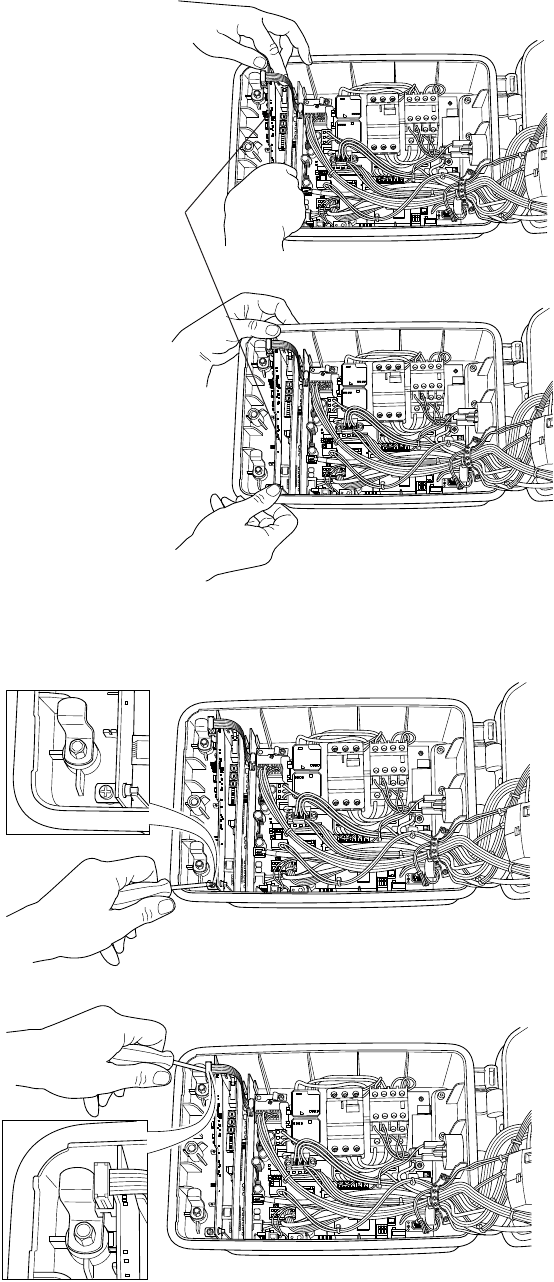
16
211 267 44.indd/151014 © Terex MHPS GmbH
To install the radio receiver card, proceed as follows:
– Before starting any installation work, disconnect the system from the power
supply.
– Install the radio receiver card in the appropriate slot
– Fix the radio receiver card in the electric equipment cover by means of the two
screws
Insert the radio receiver card into the
appropriate slot
42354344.eps
42354444.eps
42354544.eps
5.2 Installing the radio
receiver card
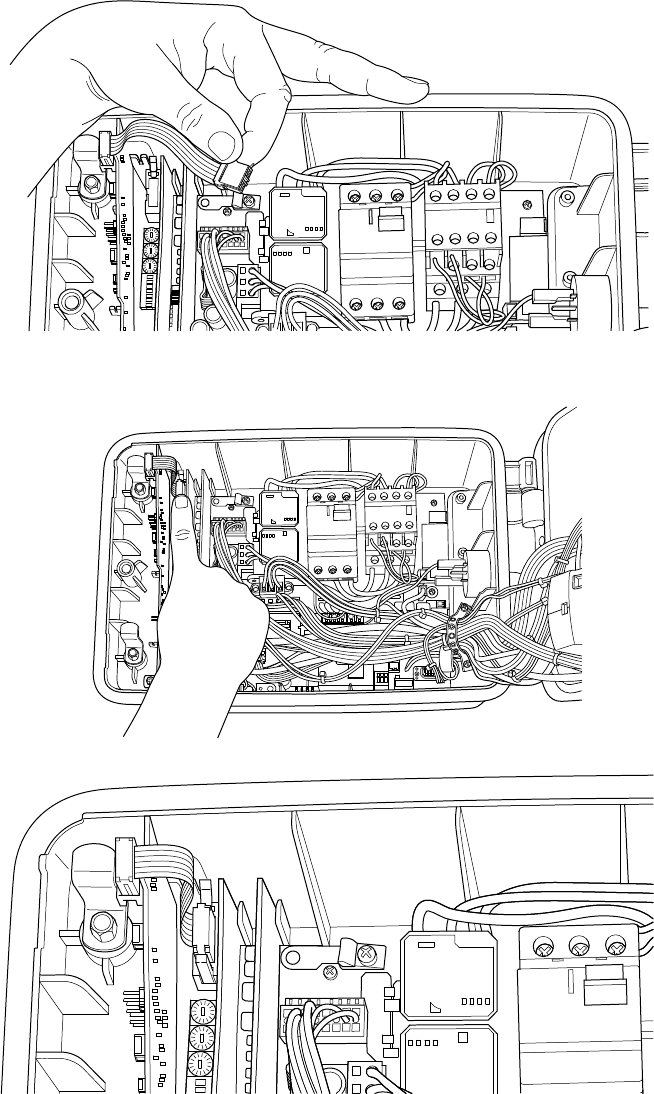
17
211 267 44.indd/151014 © Terex MHPS GmbH
– Connecting the flat cable from the radio receiver to the controller card of the
rope hoist control system
– Installation of the radio receiver card is finished when the above steps been
completed. Before the system is put into operation again, make sure that other
control components such as, for example, the DSE-10R control pendant with
cable, have been disconnected from the system. Otherwise, no clear assign-
ment of the control units is possible.
42354644.eps
42354844.eps
42354744.eps
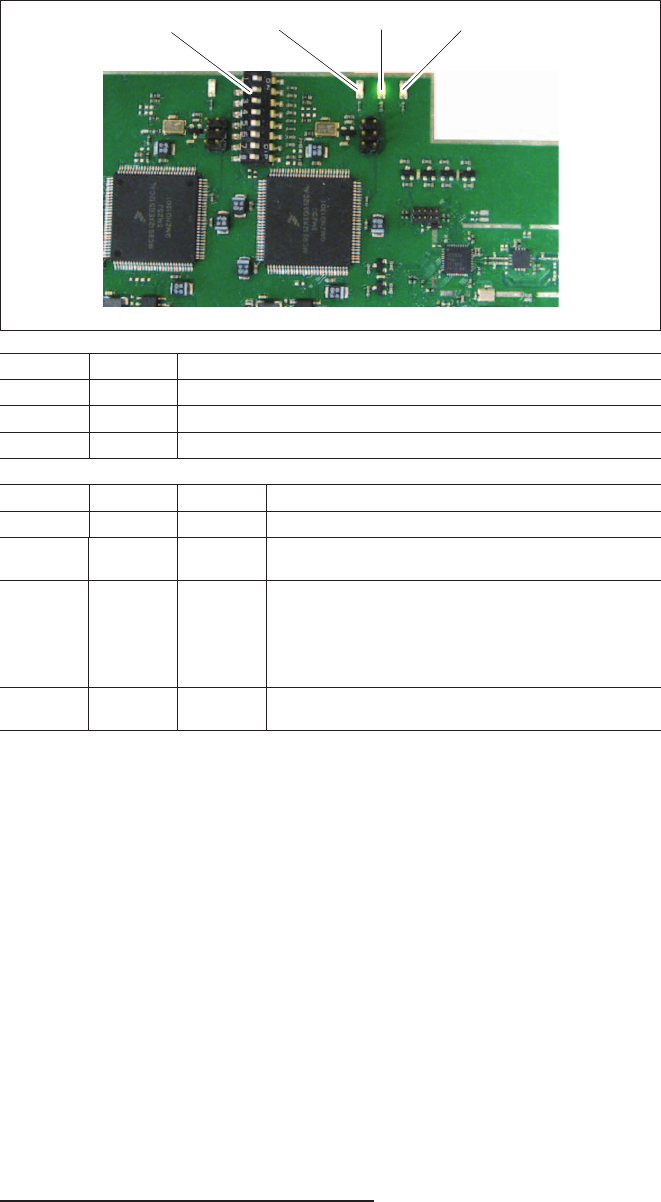
18
211 267 44.indd/151014 © Terex MHPS GmbH
5.3 Function following
installation
A general function check of the radio receiver card can be carried out by means of
the light emitting diodes.
5.4 Putting the receiver
into operation for the
first time
Further function checks are only possible by operation of the corresponding
DRC-10 or DRC-J radio transmitters. For this purpose, please refer to the
operating/assembly instructions for the relevant DRC-10 or DRC-J radio
transmitter and for the crane installation (see accompanying documents, page 2).
You will also find corresponding instructions for eliminating possible faults in a
radio control system in the operating/assembly instructions for the DRC-10 or
DRC-J radio transmitter and the crane installation.
When delivered, the DRC-DR radio receiver has crane ID “NOID”.
All crane movements are blocked. This block is removed when the unit is put into
operation by the assignment of a valid crane ID (other than NOID) to the receiver.
The radio receiver can be put into operation by means of the relevant radio
transmitter (DRC-10 or DRC-J). The procedure for putting the radio control system
into operation is described in detail in the operating/assembly instructions for the
transmitter.
Operating/assembly instructions required in addition:
Radio transmitter Ident. no.:
DRC-10 D3 hand-held transmitter 211 266 44
DRC-J D3 joystick transmitter 211 271 44
DIP LED1 LED2 LED3
43608844.jpg
LED Colour Meaning
LED1 Yellow Radio connection, flashing steadily
LED2 Green Power on, no error (continuously lit or flashing)
LED3 Red Error(s) occurred
LED1 LED2 LED3 Meaning
Off Flashing Off Receiver power on, no transmitter logged on
Off On Off Receiver power on. Transmitter logged on, but no radio
connection (transmitter off or on standby)
Flashing On Off Receiver has a radio connection
• Steady flashing indicates good radio connection
• Irregular flashing indicates radio interference
Radio connection exists in STOP, Run and parameter-
programming modes
Off Off On An internal error has occurred, shown on the transmitter
display

19
211 267 44.indd/151014 © Terex MHPS GmbH
The functions that can be called up with the F1, F2 or horn keys on DRC-10 and
DRC-J transmitters in connection with a DRC-DR receiver are described in the
following:
Actuate the F1 key to change the crab selection if there are several crabs.
The selection is incremented one step further every time the key is actuated:
I => II => I+II => I
The modified crab selection is shown on the display of the transmitter.
If there is only one crab, the F1 key has no function.
NOTE
After the transmitter is fully switched off:
or after the rechargeable battery is replaced, the crab selection always starts
with crane crab 1 when the system is restarted; this means that hoist unit 1
always starts first when the system is restarted.
i
DANGER
If the selection settings on the transmitter are ignored, e.g.
for tandem operation.
Failure to comply with the selection settings on the transmitter repre-
sents an immediate hazard which can result in serious injury or death.
You must always set the crab selection on the transmitter when it is switched
on again after it has been fully switched off.
If the parameters are programmed as follows, the current load value of the
selected crab(s) is saved as a tare value when the F2 key is actuated for 5
seconds.
The F1 and F2 keys can also be assigned optional additional functions (e.g. switch
between tandem units, etc.).
When the 1st stage of the Horn key is actuated, the horn in the crab control system
is activated.
When the 2nd stage of the Horn key is actuated and held down for more than
5 seconds, the limit switch test is activated for hoist units that are equipped with
operating limit switches.
6 Using DRC radio controls
6.1 DRC-DR receiver
operating functions
in connection with a
transmitter
6.1.1 F1 function key
Example: tandem operation
6.1.2 F2 function key
6.1.3 F1/F2 function keys –
additional functions
6.1.4 Horn key, 1st stage
6.1.5 Horn key, 2nd stage

20
211 267 44.indd/151014 © Terex MHPS GmbH
7 International postal approval
DRC D3 transmitters and receivers in the standard delivery form can be
operated without any registration or operating fee in the following countries:
Countries Frequency range
Austria
2,4-GHz ISM band
Belgium
Bulgaria
Croatia
Cyprus
Czech Republic
Denmark
Estonia
Finland
France
Germany
Greece
Hungary
Iceland
Ireland
Italy
Latvia
Liechtenstein
Lithuania
Luxembourg
Malta
Netherlands
Norway
Poland
Portugal
Romania
Slovakia
Slovenia
Spain
Sweden
Switzerland
United Kingdom

Hereby we,
Terex MHPS GmbH
Forststrasse 16, 40597 Düsseldorf, Germany
declare that the radio control system for cranes and hoists
Demag DRC, consisting of:
DRC -10 transmitter Ident. no. 773 591 44
DRC-J transmitter Ident. no. 773 593 44
DRC-DR receiver Ident. no. 719 439 44
DRC-MP receiver Ident. no. 773 594 44
of serial design are in conformity with the provisions of the following relevant regulation:
EC Low Voltage Directive 2006/95/EC
The product additionally complies with the following relevant directives/provisions:
EC EMC Directive 2004/108/EC
EC RTTE Directive 1999/5/EC
Applied harmonised standards and/or C standard drafts, in particular:
EN 13557 Cranes - Control elements and control positions
EN ISO 13849-1 Safety of machinery - Safety-related parts
of control systems - Part 1: General principles for design
Stop function: Category 3, PL d
EN 14492-2 Cranes - Power driven winches and hoists -
Part 2: Power driven hoists
EN 60204-32 Safety of machinery - Electrical
equipment of machines - Part 32:
Requirements for hoisting machines
Wetter, 21.11.2014
i.V. Dr. Thomas Bönker i.V. Dirk Schulte
Business Line Handling Technology & Drives
Components Engineering & Development
Terex Material Handling
Subject to change. No liability for errors or omissions
Ident. number / Language
19968044 / EN
Issue Page
0714 1/ 1
Original
EC conformity declaration
in the meaning of EC Directive 2006/95/EG, Annex III
U02180

22
211 267 44.indd/151014 © Terex MHPS GmbH
P FCC and Industry Canada Information
FCC information
This device complies with part 15 of the FCC Rules. Operation is subject to the following two conditions:
(1) This device may not cause harmful interference, and (2) this device must accept any interference
received, including interference that may cause undesired operation.
This equipment has been tested and found to comply with the limits for a Class A digital device, pursuant
to part 15 of the FCC Rules. These limits are designed to provide reasonable protection against harmful
interference when the equipment is operated in a commercial environment. This equipment generates,
uses, and can radiate radio frequency energy and, if not installed and used in accordance with the
instruction manual, may cause harmful interference to radio communications.
Operation of this equipment in a residential area is likely to cause harmful interference in which case the
user will be required to correct the interference at his own expense.
Warning
Changes or modifications not expressly approved by the party responsible for compliance could void the
user’s authority to operate the equipment.
Industry Canada Information
This device complies with Industry Canada licence-exempt RSS standard(s). Operation is subject to the
following two conditions: (1) this device may not cause interference, and (2) this device must accept any
interference, including interference that may cause undesired operation of the device.
Le présent appareil est conforme aux CNR d’Industrie Canada applicables aux appareils radio exempts
de licence. L’exploitation est autorisée aux deux conditions suivantes : (1) l’appareil ne doit pas produire
de brouillage, et (2) l’utilisateur de l’appareil doit accepter tout brouillage radioélectrique subi, même si le
brouillage est susceptible d’en compromettre le fonctionnement.
CAN ICES-3 (A)/NMB-3(A)
The antenna(s) used for this transmitter must be installed to provide a separation distance of at least 20
cm from all persons and must not be co-located or operating in conjunction with any other antenna or
transmitter.
The installer of this radio equipment must ensure that the antenna is located or pointed such that it does
not emit RF field in excess of Health Canada limits for the general population; consult Safety Code 6,
obtainable from Heath Canada’s website www.hc-sc.gc.ca/rpb.
L’antenne (s) utiliseé pour cet émetteur doit être installé pour fournir une distance de séparation d’au
moins 20 cm de toute personne et ne doit pas être co-localisées ou opérant en conjonction avec une
autre antenne ou émetteur.
L'installateur de cet équipement radio doit veiller à ce que l'antenne est située ou orientée de façon qu'il
ne dégage pas de champ RF dépassant les limites de Santé Canada pour la population générale;
Consultez le Code de sécurité 6, disponible sur le site web de www.hc-sc.gc.ca/rpb de Santé Canada.
Printed in Germany
Reproduction in whole or in part only with prior consent of Terex MHPS GmbH, 58286 Wetter (Germany) Subject to change. Not liable for errors or omissions.
The current addresses of our sales offices, subsidiaries and agencies worldwide can be
found on the Terex MHPS GmbH homepage at
www.demagcranes.com/Contact
Terex MHPS GmbH
PO Box 67 · 58286 Wetter (Germany)
Phone +49 (0 )2335 92-0
Fax +49 (0 )2335 92-7676
www.demagcranes.com